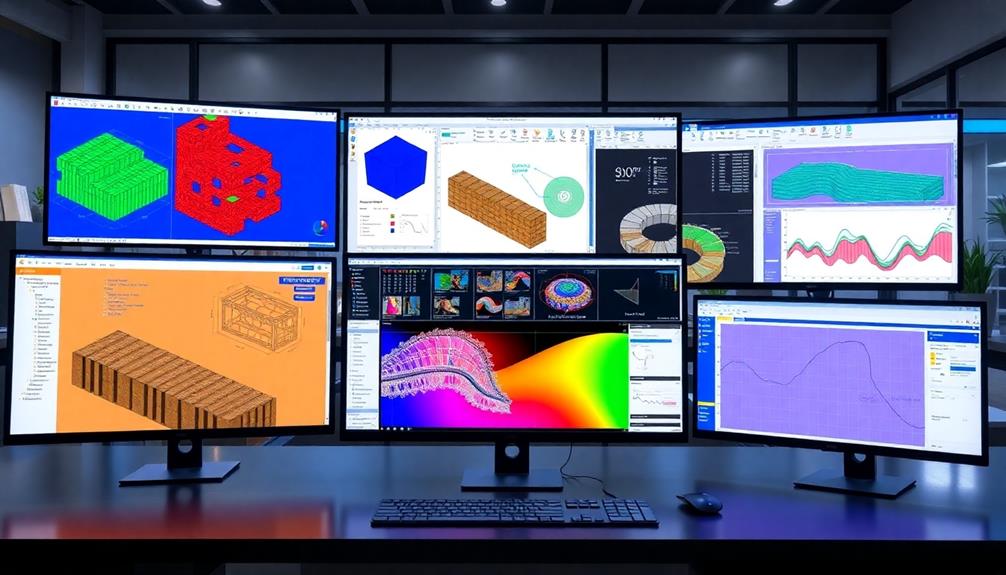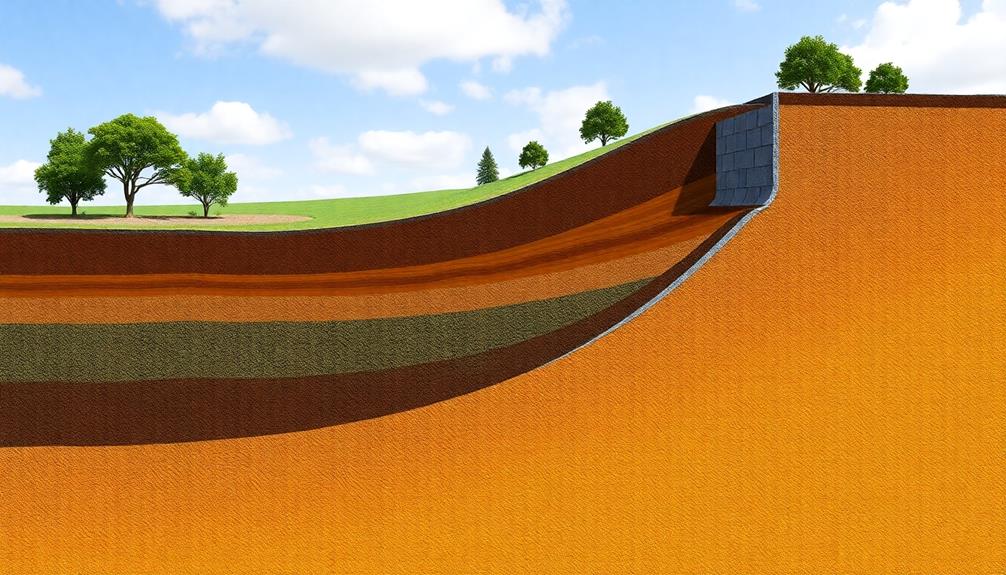In the domain of retaining wall engineering, specialized software plays a pivotal role, offering advanced features that guarantee precise design and analysis. These tools facilitate geotechnical evaluations with extensive soil-structure interaction models, and enable compliance with international design codes. Their intuitive interfaces contribute to productivity by simplifying data management and enhancing navigation through complex workflows. Flexible licensing and cost structures cater to varied project and organization needs. The software's adaptability to multiple soil types, alongside its 3D visualization capabilities, ensures durable stability assessments, further optimizing project outcomes. Next, consider exploring detailed functionalities that define these industry-leading solutions.
Table of Contents
ToggleWalls Contractor Highlights
- Popular software provides intuitive interfaces to streamline modeling, analysis, and enhance project accuracy for retaining walls.
- Key features include 3D visualization, geotechnical analysis, and design code compliance to optimize retaining wall projects.
- Software supports extensive collaboration through shared dashboards, version control, and multidisciplinary team communication.
- Flexible licensing includes one-time purchases or subscriptions, catering to different project needs and team sizes.
- Advanced algorithms ensure design accuracy by assessing structural integrity and soil compatibility.
Introduction to Retaining Wall Software

Retaining wall software serves as a pivotal tool in the engineering field, encompassing a broad spectrum of features that enhance project accuracy and efficiency. Companies like Boulder Walls have established themselves as experts in building custom retaining walls, utilizing specialized equipment and focusing on structural integrity.
The software's user interface is designed to be intuitive, providing engineers with accessible controls that streamline the modeling and analysis processes, while its cost and licensing options vary, offering flexible solutions tailored to different project needs and budgets.
Understanding these critical components is essential for selecting software that aligns with specific engineering objectives and operational constraints.
Software Features Overview
Modern engineering relies heavily on advanced technologies, and retaining wall design is no exception. As structural integrity and safety become ever more critical, software developers have tailored extensive features to meet the needs of professionals.
These retaining wall engineering software solutions serve as indispensable tools, enhancing the precision and efficiency of design and analysis tasks. When we delve deeper into the broad spectrum of features available, we can see how these technological advancements are crafted to foster a unified engineering community.
Key features intrinsic to such software include:
- Geotechnical Analysis: With complex soil-structure interaction models, these applications provide precise insights into the behavior and stability of varying soil types under assorted conditions.
- Material and Load Calculation: Built for accuracy, this feature supports engineers in calculating various input scenarios, accommodating differing material strengths and dynamic load considerations.
- Design Code Compliance: Software often comes preloaded with international design codes, ensuring regulatory adherence and reliability across all geographical locations.
- 3D Visualization and Modelling: By offering intuitive three-dimensional representations, the software allows professionals to visualize potential outcomes, facilitating error identification and design optimization.
In essence, retaining wall engineering software not only streamlines design processes but also creates a shared language through extensive features, drawing its users into a cohesive professional fabric.
User Interface Design
While functionality is paramount, the user interface design of retaining wall engineering software plays a pivotal role in user experience and productivity. The interface acts as a bridge between complex engineering data and the user, requiring careful design to guarantee both intuitiveness and efficiency.
A well-designed user interface (UI) allows engineers to navigate seamlessly through features, minimizing learning curves and maximizing focus on project objectives. For professionals in the retaining wall space, where precision and accuracy are critical, an intuitive UI serves as an ally, reinforcing a sense of competence and assurance.
Today's leading retaining wall software solutions excel by providing customizable dashboards and clear visualizations, enhancing the ability to manage complex datasets effortlessly. These interfaces typically offer responsive design and adaptability, supporting various devices and making information accessible wherever needed.
Elements such as drag-and-drop functionality, real-time simulation feedback, and thorough error-checking tools epitomize effective UI design. Furthermore, supportive communities surrounding these software solutions emphasize the collaborative nature of UI refinement, as user feedback continuously shapes iterative improvements.
Hence, a user interface not only aids individual users but also contributes to a collective progress within the retaining wall engineering community, fostering a shared sense of belonging and professional growth.
Cost and Licensing
Beyond the user interface design, which enhances the interaction experience of engineers with retaining wall software, cost and licensing are key considerations for professionals evaluating these digital tools. Ensuring that the software package fits within budgetary constraints while simultaneously meeting project demands is a balancing act that requires careful evaluation.
Licenses can differ broadly based on user requirements and the breadth of features offered. Herein lies the necessity to select a plan that aligns with both current needs and potential future expansion without unnecessary expenditure.
Key aspects to examine include:
- Pricing Models: Software may be offered as a one-time purchase, subscription, or pay-per-feature model. Understanding these options helps in forecasting both immediate and long-term costs.
- Licensing Terms: Take into account whether the software license is single-user, multi-user, or organization-wide. Such variations influence not only cost but also usability within engineering teams.
- Updates and Support: Regular software updates and dedicated support often come attached to particular licenses, making their presence critical for maintaining software efficacy and handling technical issues.
- Scalability: Evaluate the flexibility of software in accommodating growing project scopes or team sizes. Scalable solutions may prove invaluable in dynamic professional environments.
Consideration of these factors can yield significant strategic benefits, ensuring that the selected software encapsulates value beyond its monetary cost.
Benefits

Retaining wall engineering software revolutionizes project execution by substantially enhancing cost and time efficiency while delivering superior design accuracy through automated computations and robust error-checking capabilities.
The software's user-friendly interface guarantees that both seasoned engineers and newcomers can navigate complex processes with ease, facilitating seamless project workflow. These platforms also excel at incorporating various retaining wall materials into designs, from traditional limestone to natural boulders, allowing for more creative and site-specific solutions.
Additionally, these platforms promote enhanced project collaboration, allowing teams to share updates and work cohesively, which is particularly vital in large-scale engineering projects.
Cost and Time Efficiency
A key advantage offered by retaining wall engineering software is its ability to markedly enhance cost and time efficiency in construction projects. This advantage is pivotal, as projects often face constraints related to budget and deadlines which can hamper successful execution. By streamlining numerous processes, the software guarantees that both resources and time are ideally utilized. This not only benefits the project managers and engineers who are involved in project execution but also the broader community, as efficient projects can elevate infrastructure and environmental aesthetics without unnecessary delays or excessive costs.
- Automated Calculations: The software automates complex calculations, drastically reducing the man-hours traditionally required and minimizing the likelihood of human error, ultimately saving time and resources.
- Resource Management: With real-time data input, resource allocation becomes more effective, enabling project teams to focus their efforts better and respond dynamically to changes, thereby minimizing downtime.
- Project Simulations: These simulations assist in understanding potential challenges, bypassing trial-and-error on actual sites, which makes time allocation more predictable and cost-effective.
- Documentation and Compliance: Generated reports aid in maintaining regulatory compliance and provide all stakeholders with clear, concise documentation, thus reducing legal and logistic expenditures related to maintaining alignment with standards.
Improved Design Accuracy
Precision in engineering design is crucial, and retaining wall engineering software considerably enhances design accuracy, which is invaluable for successful project outcomes. These sophisticated platforms incorporate advanced algorithms and computational techniques to guarantee that the designs are not only structurally sound but also optimized for the specific site conditions.
By automating complex calculations and incorporating real-world variables such as soil properties, load magnitudes, and environmental factors, the software provides engineers with a thorough and precise design solution.
Furthermore, these tools facilitate the integration of real-time data, allowing for dynamic adjustments to the design as new information becomes available. This adaptability guarantees that the final retaining wall design is both robust and capable of withstanding unforeseen challenges, thus increasing client confidence and satisfaction. Additionally, the software's precision minimizes material waste and reduces the risk of costly errors, aligning with sustainable construction practices.
As the role of digital solutions in engineering steadily increases, embracing these innovations fosters a sense of community among engineers and stakeholders. By leveraging improved design accuracy, professionals can engage in more collaborative and informed decision-making processes, ultimately leading to enhanced project outcomes and strengthened professional relationships.
User-Friendly Interface Features
Modern engineering software for retaining walls is renowned for its user-friendly interface, vastly enhancing user experience and operational efficiency. By simplifying complex processes, such software brings together various stakeholders, empowering them to contribute and engage effortlessly in project development. A user-friendly interface serves as a conduit for knowledge sharing and skills enhancement, allowing users to explore intricate design variables within a comprehensible framework. This integration of technology and simplicity aids in cultivating a communal environment where engineers feel seamlessly connected to their tools and projects.
To provide further insights, consider the following features that solidify these benefits:
- Intuitive Navigation: Simplified menu structures and logical workflows minimize the learning curve, making it accessible for both novices and seasoned professionals.
- Visual Representation: High-quality graphics and 3D modeling facilitate visual learning and precise project visualizations, enhancing comprehension and design accuracy.
- Customizable Templates: Users can tailor interfaces and outputs to align with specific project demands, promoting individualized control over data entry and analysis.
- Real-Time Feedback: Instant analytical results and error-checking functionalities promote on-the-fly adjustments, ensuring continuous project improvement without unnecessary delays.
Together, these features foster an inclusive atmosphere within engineering teams, strengthening both individual capabilities and collective accomplishments.
Enhanced Project Collaboration
Effective collaboration is pivotal in the successful execution of engineering projects, and advanced retaining wall engineering software considerably boosts this aspect. By integrating seamless communication features, these software solutions enable multidisciplinary teams—comprising engineers, architects, and project managers—to synchronize their efforts efficiently. This integration fosters a cohesive environment where stakeholders can access and share pertinent information in real-time, thereby minimizing the risk of misinformation and project delays.
A key benefit of such software is its ability to create a unified platform that consolidates all project-related data, making it accessible to all team members. This transparency not only fortifies trust among collaborators but also enhances accountability, as each member can consistently track progress and contributions. Additionally, version control features maintain that all users are working with the most up-to-date data and designs, considerably reducing the likelihood of costly errors.
Moreover, advanced retaining wall engineering software often includes collaborative tools such as shared dashboards and task management systems. These facilitate effective project tracking and workload distribution, ensuring that every team member is aware of their responsibilities and timelines. Ultimately, enhanced project collaboration through sophisticated software solutions helps maintain efficient project delivery, while fostering a sense of unity and shared purpose among team members.
Suitable Soil Types Compatibility

When selecting retaining wall engineering software, guaranteeing compatibility with various soil types is pivotal, as it directly impacts the integrity and safety of the construction. Advanced features such as soil type analysis, compatibility checks, and stability assessment tools help engineers determine the best practices for using materials suited to specific site conditions. The table below outlines key features of retaining wall software relevant to soil type compatibility:
| Feature | Description | Benefit |
|---|---|---|
| Soil Type Analysis | Identifies and categorizes different soil types | Guarantees appropriate design choice |
| Software Soil Compatibility | Matches software parameters with soil characteristics | Enhances structural reliability |
| Stability Assessment Tools | Evaluates potential risks associated with soil | Minimizes project risks |
Soil Type Analysis Features
Understanding the compatibility of various soil types is often pivotal in the engineering of retaining walls, making soil type analysis features an indispensable component of specialized software. These features help engineers evaluate soil properties, guaranteeing safe and effective wall designs.
Retaining wall engineering software offers tools that meticulously examine and forecast the behavior of different soil types when subjected to stress and movement over time. To ensure the structural integrity of a retaining wall, reliable assessments of soil resistance, drainage, and overall stability are integral.
The strategic use of soil analysis features promotes the construction of resilient and durable structures while fostering a sense of assurance and belonging within a community that relies upon such infrastructure. Below are four key aspects of soil type analysis features that aid in achieving ideal compatibility:
- Soil Classification Systems: Enables precise identification based on unified soil classification, ensuring engineers align specifications with local standards.
- Load-Bearing Capacity Assessment: Assesses varying soil strengths to ensure that wall designs consider load demands.
- Soil Settlement Prediction: Anticipates potential soil compression over time, contributing to improved wall longevity.
- Soil-Structure Interaction Simulation: Models complex interactions to prevent failures, therefore enhancing safety and connectivity in community environments.
Software Soil Compatibility
Facilitating seamless integration between retaining wall designs and varying soil conditions, retaining wall engineering software is equipped with features that guarantee soil compatibility, thereby enhancing structural reliability. This capability allows engineers and designers to select the most fitting wall type, considering the diverse characteristics of soil encountered on site. With a comprehensive database of soil types, the software assists users in evaluating factors such as soil shear strength, cohesion, and friction angle, which are indispensable for ensuring the stability and longevity of retaining walls.
Moreover, advanced algorithms analyze soil-structure interaction, offering detailed insights into how different soil compositions might affect wall performance under varying load conditions. The software's adaptability provides tailored solutions, enabling users to customize designs in line with the unique demands of their projects. Such adaptability fosters a sense of belonging among professionals, who can rely on precise data tailored to the idiosyncrasies of their site's soil profile.
Inclusive access to updated geological data is another pertinent feature, ensuring compatibility with contemporary engineering requirements. This integration-enabled approach streamlines the design process, reduces risk of structural failure, and supports the creation of safe, enduring constructions resonating with professional standards and community expectations.
Stability Assessment Tools
While designing retaining walls, ensuring stability is paramount, particularly when confronting varying soil types. Stability assessment tools in retaining wall engineering software are indispensable for evaluating soil compatibility, as inappropriate soil selection can lead to structural failures. These tools provide thorough analyses, aiding engineers in making informed decisions, enhancing both safety and design efficiency.
The nuanced interplay between soil properties and wall stability can be effectively navigated with the use of cutting-edge software designed for the following purposes:
- Soil Classification: Advanced tools categorize soil based on mechanical properties, allowing precise prediction of wall behavior under different geotechnical conditions.
- Load Analysis: Engineers can simulate various load scenarios to ascertain the impact on wall stability, considering factors like earth pressure, surcharge loads, and hydrostatic pressures.
- Safety Factor Calculation: By evaluating critical failure surfaces, software can determine safety factors, ensuring that designs meet regulatory and safety standards.
- Bearing Capacity Assessment: These tools assess the bearing capacity of soil, ensuring that the foundation is robust enough to support the proposed retaining wall structure.
Walls Contractor FAQ
What Are the Costs Associated With Each Software?
The costs associated with engineering software vary greatly, typically ranging from a few hundred to several thousand dollars annually. These expenses are influenced by factors such as licensing models, software capabilities, and ongoing support and updates offered by providers.
Are Training Resources Available for Beginner Users?
Training resources for beginners are often provided by software developers, including online tutorials, user manuals, and webinars. These resources aim to foster community engagement and ease of learning, thereby enhancing user competence and confidence.
How Often Do These Software Receive Updates?
Software updates are vital for maintaining program integrity, ensuring security, and incorporating advances. Many engineering applications receive updates ranging from quarterly to annually, fostering a sense of community among users invested in achieving ideal performance and innovation.
Is Customer Support Available and in What Forms?
Customer support is typically available in several forms including email, phone, and live chat. Engaging with technical professionals guarantees timely assistance, fostering a supportive community where users feel valued and their concerns addressed efficiently.
Can the Software Integrate With Other Engineering Tools?
Integration capabilities with other engineering tools enhance workflow efficiency and foster collaboration among professionals. This software supports compatibility with several industry-standard platforms, ensuring seamless data exchange and empowering engineers to work cohesively within their preferred technical ecosystems.







